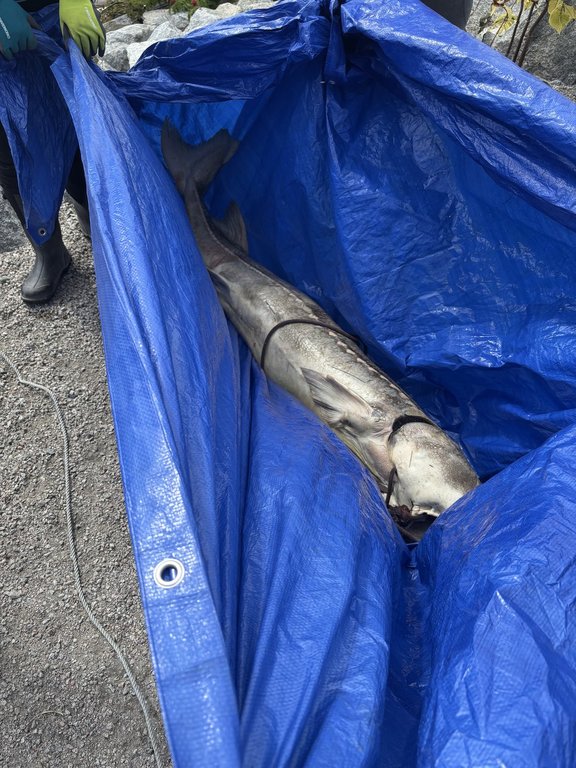Science
Tsawwassen First Nation Investigates Rising Sturgeon Deaths

Recent investigations by the Tsawwassen First Nation have been prompted by an alarming increase in sturgeon deaths along the Fraser River in British Columbia. Earlier this month, a team of four removed the carcass of a sturgeon, measuring approximately 1.6 meters, from the riverbank in Richmond. This case is part of a troubling trend, with dozens of sturgeon washing up dead in the area.
The dead sturgeon collected will be frozen for research purposes, as the First Nation seeks to understand the causes of these mortality events. The objective is to eventually return the carcasses to the river equipped with electronic trackers, which will aid in monitoring their movements and environmental conditions.
Kelly Scott, a biologist with the Tsawwassen First Nation, emphasized the importance of these fish, describing them as “like dinosaurs,” with a history spanning over 200 million years. The recent mortality events raise significant concerns about environmental changes impacting their survival.
Reports from local residents indicate that multiple sturgeon have been observed floating in the river simultaneously, further intensifying worries about the health of the species. According to the British Columbia Ministry of Land, Water and Resource Stewardship, there has been a noted increase in sturgeon mortality this year, though the precise scale of the issue is still being assessed. The ministry confirmed receiving reports of 71 dead sturgeon across the province since July, with 65 of these found in the lower Fraser River. Notably, 49 of these reports were logged in just the last four weeks.
Historically, the population of white sturgeon, which can grow up to six meters and live over 100 years, has been significant for the First Nations communities that traditionally harvest them for food and cultural practices. Harvesting sturgeon was prohibited by the province in 1994, and First Nations voluntarily ceased their sturgeon harvests at that time. Despite this, catch-and-release fishing remains permitted in the lower Fraser River. The recent discoveries coincide with a temporary recreational opening for sockeye salmon, raising questions about potential impacts on sturgeon populations.
Many factors could explain the sturgeon mortality, with climate change being a primary concern. Scott noted that rising water temperatures create stress for the fish, as there are fewer shaded areas in the river providing thermal refuge. She explained that if a sturgeon is already under stress when caught in nets for other species, it increases the likelihood of mortality.
The research team aims to identify cooler habitats for sturgeon and will undertake restoration efforts in these areas. Additionally, threats from large vessel propeller strikes have been highlighted, as evidenced by one sturgeon found with a significant gash on its back.
In their efforts, the team is collecting data on injuries observed on the sturgeon carcasses, with a goal of gathering at least 20 specimens for study. Unfortunately, many carcasses have been too decomposed for collection. The researchers plan to track the movements of these carcasses downstream under various environmental conditions, including different seasons and weather patterns.
The initiative seeks to understand the underlying causes of sturgeon mortality and determine if the reported deaths accurately reflect the true mortality rate. Scott’s team is also collaborating with a researcher at the University of B.C. to utilize environmental genomics. This method involves analyzing DNA and RNA from aquatic samples to gain insights into the sturgeons’ habitat preferences and stress levels.
The provincial ministry acknowledged that multiple factors, including disease and elevated summer water temperatures, likely contribute to the sturgeon deaths. They clarified that there is currently no direct evidence linking the recent salmon fishery to the sturgeon mortality.
Water temperatures in the Fraser River exceeded 20 C during the latter part of the summer, increasing the risk of stress and mortality among sturgeon as temperatures surpass 18 C. While the uptick in fishing activity may correlate with the increased reports of dead sturgeon, it may also explain the heightened visibility of these incidents.
Sturgeon are protected under federal species-at-risk legislation across much of British Columbia, with specific populations listed as endangered since 2006. The Committee on the Status of Endangered Wildlife in Canada has assessed the lower Fraser population as threatened, although it has not yet been granted legal protection.
For catch-and-release fishing in the lower Fraser, a special conservation license is required, and guidelines stress the importance of minimizing stress on the fish. Anglers are advised not to lift sturgeon out of the water to prevent internal injuries and to ensure quick releases, as sturgeon that are played for too long may not recover.
In 2021, British Columbia initiated a management plan for white sturgeon across the Fraser River basin. This plan involves a steering committee that includes provincial and First Nations representatives, alongside input from the Fisheries Department.
The ongoing research by the Tsawwassen First Nation aims to shed light on the complexities surrounding sturgeon mortality, contributing to the broader conversation on conservation efforts in the region.
-

 Politics4 weeks ago
Politics4 weeks agoSecwepemc First Nation Seeks Aboriginal Title Over Kamloops Area
-

 World5 months ago
World5 months agoScientists Unearth Ancient Antarctic Ice to Unlock Climate Secrets
-

 Entertainment5 months ago
Entertainment5 months agoTrump and McCormick to Announce $70 Billion Energy Investments
-

 Science5 months ago
Science5 months agoFour Astronauts Return to Earth After International Space Station Mission
-

 Lifestyle5 months ago
Lifestyle5 months agoTransLink Launches Food Truck Program to Boost Revenue in Vancouver
-

 Technology3 months ago
Technology3 months agoApple Notes Enhances Functionality with Markdown Support in macOS 26
-

 Lifestyle3 months ago
Lifestyle3 months agoManitoba’s Burger Champion Shines Again Amid Dining Innovations
-

 Top Stories2 months ago
Top Stories2 months agoUrgent Update: Fatal Crash on Highway 99 Claims Life of Pitt Meadows Man
-

 Politics4 months ago
Politics4 months agoUkrainian Tennis Star Elina Svitolina Faces Death Threats Online
-

 Sports5 months ago
Sports5 months agoSearch Underway for Missing Hunter Amid Hokkaido Bear Emergency
-

 Politics5 months ago
Politics5 months agoCarney Engages First Nations Leaders at Development Law Summit
-

 Technology5 months ago
Technology5 months agoFrosthaven Launches Early Access on July 31, 2025





















